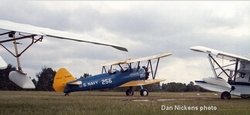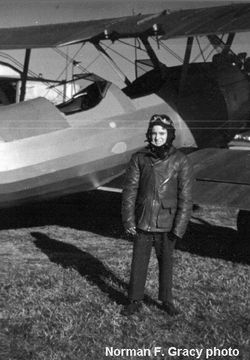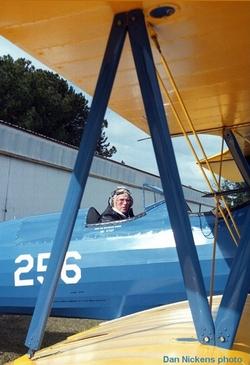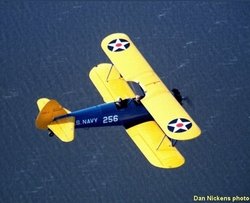By ANN Reader Dan Nickens
 The sleepy southern fields of December jumped to
the staccato roar of seven unmuffled cylinders. The air
reverberated and settled into a steady beat as the old airplane
shook to life one more time. Inside the cockpit a dream decades in
the making was being reaffirmed. The man and flying machine
intersected again more than half a century after the dream was just
a juvenile longing.
The sleepy southern fields of December jumped to
the staccato roar of seven unmuffled cylinders. The air
reverberated and settled into a steady beat as the old airplane
shook to life one more time. Inside the cockpit a dream decades in
the making was being reaffirmed. The man and flying machine
intersected again more than half a century after the dream was just
a juvenile longing.
The seasoned pilot gazed over the long blue nose stuck between
the two yellow wings of the Stearman biplane. The smell of the
leather lined cockpit and the engine oil mixed sweetly just as he
remembered. The same two eyes had been wide open staring at the big
round engine in 1946. He was only thirteen then and his dream of
taking to the air was realized for the first time.
For the boy growing up in a modest Norfolk (VA) neighborhood,
the thought of flying was all-consuming. He read everything about
flying he could get his hands on. He made model airplanes to
simulate flight. He worshipped the flying heroes returning from
winning a world war. His prospects for ever following their path
into the air, however, seemed wildly hopeless.
Dad understood.
 His father understood the passion of the boy's
dream. He prevailed upon a friend of his to take the boy for a
flight in a surplus military trainer. There was, however, a
technical problem: the friend was just a student pilot. Student
pilots cannot carry passengers.
His father understood the passion of the boy's
dream. He prevailed upon a friend of his to take the boy for a
flight in a surplus military trainer. There was, however, a
technical problem: the friend was just a student pilot. Student
pilots cannot carry passengers.
Seeing the boy's desire, the long-time student made an
appointment with the Civil Aviation Administration (the FAA's
predecessor) to ride with an inspector for his license. He flew to
the appointed airport in a rented Boeing Stearman for the
checkride. [Here he is, in 1946 --ed.] The boy joined him
there in anticipation of being the newly minted pilot's first
passenger.
The CAA inspector never arrived. There would be no new pilot to
fly the boy. The boy was crestfallen.
For a kid, the rules got bent.
"Go ahead and get in," the student pilot directed, "but keep
your head down until we get up. We don't want anyone to see you in
here." He directed the boy's father to meet him at a muddy,
unattended field to retrieve the illegal passenger.
The clandestine operation surely added to the boy's adrenaline
level. Crouching down in the seat of the open cockpit he could
barely contain himself. It was the biggest excitement of his
thirteen-year life.
This time, it was legal.
 That same excitement seemed little reduced in the
intervening fifty-six years. The now-seventy-year-old man was
beaming as he advanced the throttle to move the Stearman onto the
grass strip. For this trip, the flight was completely legal. There
was an instructor riding in the front seat to administer another in
a long string of flight reviews.
That same excitement seemed little reduced in the
intervening fifty-six years. The now-seventy-year-old man was
beaming as he advanced the throttle to move the Stearman onto the
grass strip. For this trip, the flight was completely legal. There
was an instructor riding in the front seat to administer another in
a long string of flight reviews.
The boy that hid in the Stearman cockpit was now a
senior aviator. In the half-century following his first ride,
flying had been his life. He had wrangled his way into the Air
Force, flown jet bombers during critical days of the cold war, been
in a hot war in Vietnam, was nearly killed when his airplane was
shot down in Albuquerque [!], served as an Air Force advisor to the
Shah of Iran's air force, retired from the military to fly charter
flights, then retired to fly a homebuilt experimental amphibious
seaplane. By any measure, he had proven himself to be a consummate
airman.
Long trail back to the Stearman:
 As a youngster, the boy entered the U. S. Air
Force under a special program in the 1950s. As a cadet, he learned
to fly in a slightly more-modern trainer, the T-6. He was then
assigned to bombers and learned that trade by flying obsolete World
War II B-25s. He graduated to fly a multi-engine jet bomber, the
Boeing B-47 Stratojet for the Strategic Air Command.
As a youngster, the boy entered the U. S. Air
Force under a special program in the 1950s. As a cadet, he learned
to fly in a slightly more-modern trainer, the T-6. He was then
assigned to bombers and learned that trade by flying obsolete World
War II B-25s. He graduated to fly a multi-engine jet bomber, the
Boeing B-47 Stratojet for the Strategic Air Command.
Shortly before the demise of SAC, the Air Force captain
transferred to transport aircraft and was shipped off to Vietnam.
In Vietnam he flew dignitaries throughout Southeast Asia. He also
flew commandos into mountain strips at night, guided only by
flashlights the Special Forces troops arranged at the edge of the
jungle.
About getting shot down in New Mexico:
After a year, he returned to the United States without taking
any serious damage in the heat of combat. It was on a training
flight out of Albuquerque (NM), however, that he came closest to
dying in an airplane.
The dusk departure had the aviator flying as Instructor Pilot in
a C-47 'Gooney Bird.' Shortly after liftoff, a flash fire developed
in the right engine. With the crew unable to extinguish the fire or
feather the prop on the stricken engine, the plane would not stay
in the air. In a smoke-filled cockpit with zero visibility he set
up the airplane for a controlled crash. Although the aircraft was
destroyed both the instructor and his student escaped. It was later
determined that a high -caliber bullet had pierced the engine,
disabling all the critical components that led to the crash.
Iran was safer than Albuquerque.
The aviator also served time in the Middle East. He worked as a
liaison officer with the Iranian Air Force. Before retiring as a
Major and Command Pilot with five air medals, he returned to the
U.S. and flew jet transports out of Andrews Air Force Base in
Washington, DC.
Flying small jets for the Air Force led directly to a job with
an aircraft charter company. The airman flew executive jet
transports until the company he worked for went out of
business.
Retirement was better, yet.
After some years out of aviation, the self-grounded pilot
retired to Florida. Here he discovered the world of light,
homebuilt aircraft. One in particular, a kit-built seaplane, caught
his interest. He bought a Searey kit and built it. He's been
flying it for fun, on and off the water, for six years.
The FAA requires even someone of this airman's experience to
pass a flight review every two years. Since the thrill of flying
remains as strong as ever in the boy turned senior aviator, he
scheduled the flight review shortly after his seventieth
birthday.
Don't make it too easy, now...
 Instead of taking a rubber stamp check ride in a
plane he was familiar with, the persistent pilot chose to make it a
challenge. He wanted to relive the experience of his first flight
from the perspective of an accomplished pilot. He purposefully
sought out Tim Preston, a Certified Flight Instructor, owner of
Preston Aviation and one 1941 Stearman at
X55, for his flight review.
Instead of taking a rubber stamp check ride in a
plane he was familiar with, the persistent pilot chose to make it a
challenge. He wanted to relive the experience of his first flight
from the perspective of an accomplished pilot. He purposefully
sought out Tim Preston, a Certified Flight Instructor, owner of
Preston Aviation and one 1941 Stearman at
X55, for his flight review.
Preston's Stearman was developed as a trainer, but it is no easy
airplane to master. It was built when airmen flew in an open
cockpit, with minimal instruments, behind two wings in an airplane
that had little visibility for taxiing on the ground. Unlike modern
trainers, it is a demanding taskmaster.
The biplane the pilot sat in was built in 1941. Dates stamped on
the wings and ailerons showed that it started life as Pearl Harbor
was being bombed. The date of the check ride coincided with the
sixty-first anniversary of that attack.
It was impossible to tell that the airplane was that old. It was
decked out in the sparkling blue and yellow colors specified by the
Navy. It gleamed under the beckoning Florida sun. In the spirit of
the craft, the pilot chose to wear a leather flight jacket and silk
scarf. The cloth headset connected to a modern radio was one
concession to the date on the calendar.
 Watching the pre-flight ritual was a small cadre
of spectators. One remembered the thirteen-year-old boy selling
newspapers to raise money for flight time. Pauline Young, a
lifelong companion, followed the aviator to Florida when he
retired. She worked alongside him to build his little experimental
seaplane. She was now present to commemorate the renewal of the
man's lifelong dream.
Watching the pre-flight ritual was a small cadre
of spectators. One remembered the thirteen-year-old boy selling
newspapers to raise money for flight time. Pauline Young, a
lifelong companion, followed the aviator to Florida when he
retired. She worked alongside him to build his little experimental
seaplane. She was now present to commemorate the renewal of the
man's lifelong dream.
In the space of a few hours, the government's requirements were
ably met, to the instructor's satisfaction. The timeless flight
concluded with the required signature in a book logging thousands
of accumulated flight hours. One more time, Norman Frank Gracy,
Major U.S.A.F. Retired, proved to himself and the world that he was
born to fly.
[ANN Thanks Dan Nickens, "One of the Admiring Spectators," for his
insight and enterprise --ed.]
 Aero-News: Quote of the Day (04.17.24)
Aero-News: Quote of the Day (04.17.24) ANN's Daily Aero-Linx (04.17.24)
ANN's Daily Aero-Linx (04.17.24) Airborne-Flight Training 04.17.24: Feds Need Controllers, Spirit Delay, Redbird
Airborne-Flight Training 04.17.24: Feds Need Controllers, Spirit Delay, Redbird Airborne 04.16.24: RV Update, Affordable Flying Expo, Diamond Lil
Airborne 04.16.24: RV Update, Affordable Flying Expo, Diamond Lil Airborne 04.11.24: SnF24!, King's 50th, Top Rudder, Aileronics
Airborne 04.11.24: SnF24!, King's 50th, Top Rudder, Aileronics








